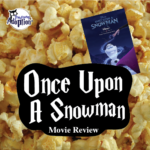
Once Upon a Snowman (2020)
Discussion Packet
Once Upon a Snowman – Discussion Guide
Discussion Guide:
- Why do you think Olaf doesn’t remember his name or who he is?
Caregiver Note: With this question we can get the conversation started about the movie before moving into tougher questions. You may discuss how Olaf wasn’t finished transforming when Queen Elsa’s cape knocked him off the mountain. It also could be because Olaf fell and hit his head. And it could just be how Queen Elsa’s magic works. - When Olaf is lost he approaches the shopkeeper. Who else could have been safe adults for Olaf to look to for help?
Caregiver Note: Sometimes children who have been raised in the midst of trauma are not taught things like “stranger danger” or how to identify safe adults. As a result, they could potentially find themselves in unsafe places if not given this lesson. Take this as an opportunity to discuss safe adults they can approach if they are ever lost or scared like a police officer, doctor, nurse, teacher, store clerk in a store, or caregivers. - How does Olaf realize he likes summer so much? Did he figure that out on his own?
Caregiver Note: Sometimes we may come to realizations about ourselves through experiences we have alone while others come with the help of others. As a snowman, Olaf would never have experienced summer himself as he would melt at this point in the timeline. But, thanks to Oaken’s viewfinder Olaf is able to see different pictures of all the beautiful things that come out in summer. This is a good way to talk about trying new things with a safe adult or friend and how we may come to like things we never thought we’d try! - What does Olaf learn through wearing a summer sausage as a nose in the woods? How can you learn from mistakes like Olaf?
Caregiver Note: Sometimes adults are so caught up in making sure children don’t make mistakes it’s easy to forget how much growth can happen when natural consequences come from a mistake. We see very quickly that Olaf did not know that wolves like meat, so when he skipped into the woods with his sausage nose he was in for the chase of his life! While this was comical for us, poor Olaf does not find this amusing and is put at a large risk. However, with this new knowledge Olaf is able to select a more appropriate nose (a carrot) later. Talk to your child about learning from mistakes and remembering them to make better choices later. - After the chase, Olaf recognizes the wolf needs the sausage more than he does and gives it to the wolf. He then says that the wolf’s licks feel like a warm hug and remembers that he loves warm hugs. How can you help others to learn more about yourself?
Caregiver Note: One way we can learn about ourselves and grow is to help others in need. Talk to your child about different ways we can feel “warm hugs” by helping others by volunteering time, being a listening ear, or giving a warm hug with consent to comfort someone that is sad. Our identity can be more than our name and what we like and can also include what we do with our actions and talents. - ACTIVITY: The Nose Knows?
Caregiver Note: This is a silly activity that can help with bonding and laughing together, which is important for connecting with your child. I came up with this idea watching Olaf react to having a sausage scented nose. We’d rather our kids not wear food like Olaf, so let’s practice with our sense of smells. Gather together 5 things with distinct smells. I’d start with some summer sausage, a cheese your child likes, some ranch dressing, cut apples, and something like peanut butter. Substitute foods to accommodate any allergies. Place each of these foods in a solid box that cannot be seen through and have an opening to be able to smell the food. Take turns with your children and guess what each item smells like. Whoever gets the most gets to pick dinner one night that week. Afterwards enjoy your snack together and talk about the short film now that you have loosened up with some fun.
You don’t have to use food and can use any combination of items but overall this one will get you all laughing fast!
[Donate to this Project]
NOTE: Inclusion on these lists does not necessarily mean endorsement. Furthermore, with all our resources, we highly recommend you preview them first to determine if there are any trauma triggers that your child may not be ready to handle. Transfiguring Adoption does not intend for its reviewers nor its reviews to be professional, medical or legal advice. These reviews and discussion guides are intended to help parents to better be able to connect and understand their children who come from traumatic backgrounds.